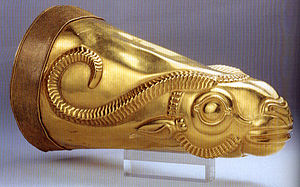
A rhyton /ˈraɪˌtɒn, ˈraɪtən/ (pl.: rhytons or, following the Greek plural, rhyta) is a roughly conical container from which fluids were intended to be drunk or to be poured in some ceremony such as libation, or merely at table. A rhyton is typically formed in the shape of an animal's head. Items were produced over large areas of ancient Eurasia, especially from Persia to the Balkans. Many have an opening at the bottom through which the liquid fell; others did not, and were merely used as drinking cups, with the characteristic that they could not usually be set down on a surface without spilling their contents.
The English word rhyton originates in the ancient Greek word ῥυτόν (rhy̆tón or rhŭtón). The conical rhyton form has been known in the Aegean region since the Bronze Age, or the 2nd millennium BC. However, it was by no means confined to that region. Similar in form to, and perhaps originating from, the drinking horn, it has been widespread over Eurasia since prehistoric times.
- ^ The horn in a continuous and graceful curve makes a right-angled bend. Its lower two thirds are covered by flutes with arc-shaped upper tips. A figural scene below the flaring rim represents the murder of Orpheus. The musician is the central figure, fallen to his right knee, flanked by three attacking Thracian women. He holds a six-string lyre on his right hand and with his left one, wrapped in his mantle, a knobbed wooden stick, with which he tries vainly to protect himself.
